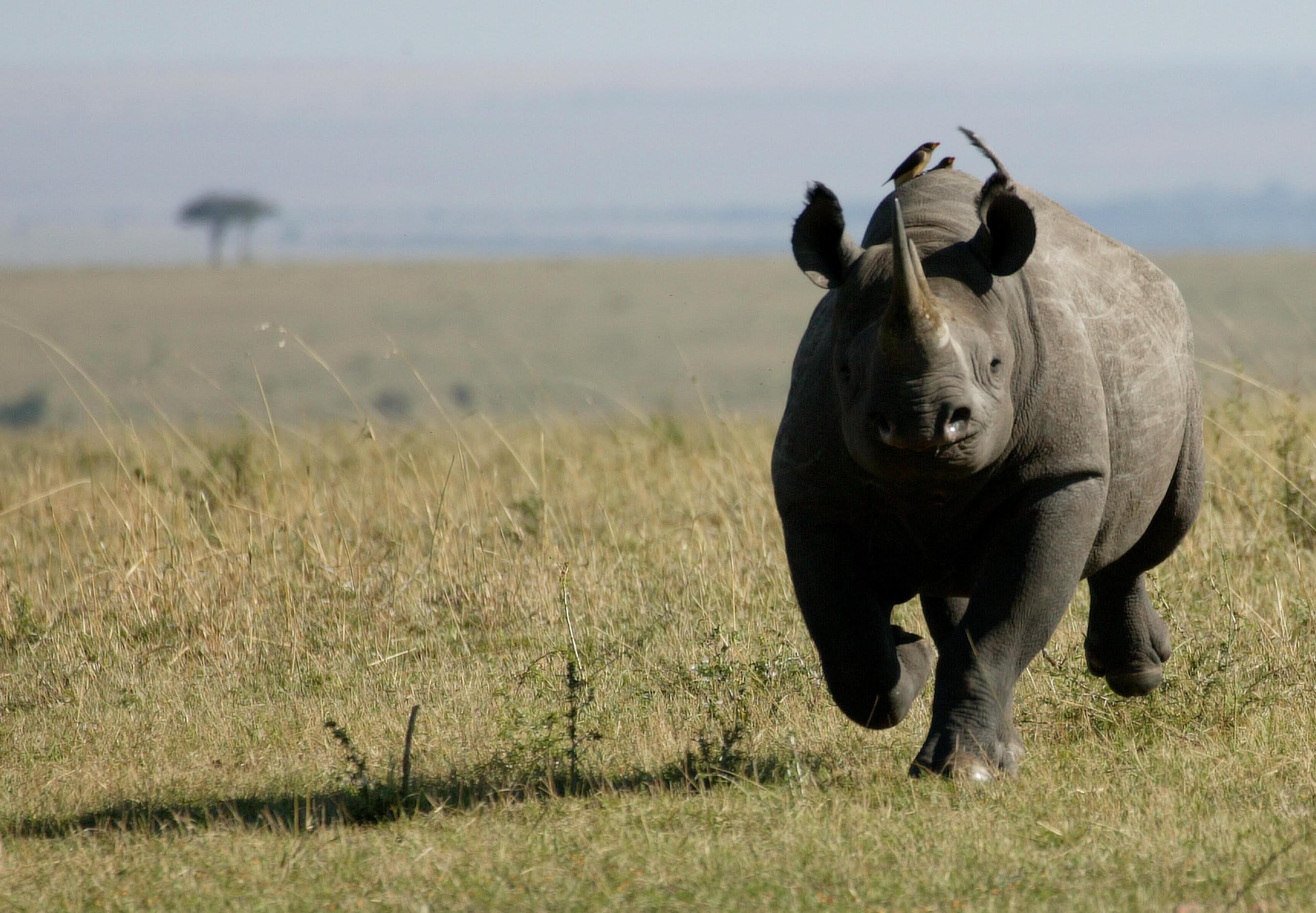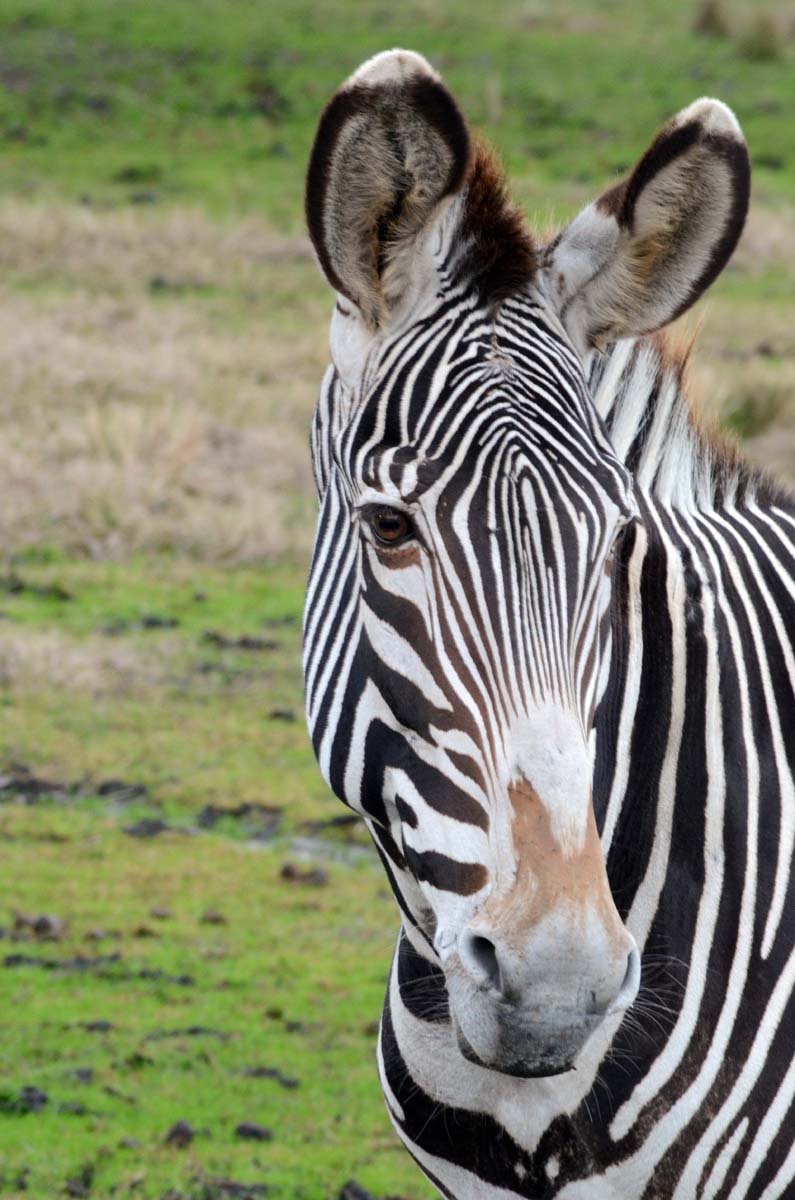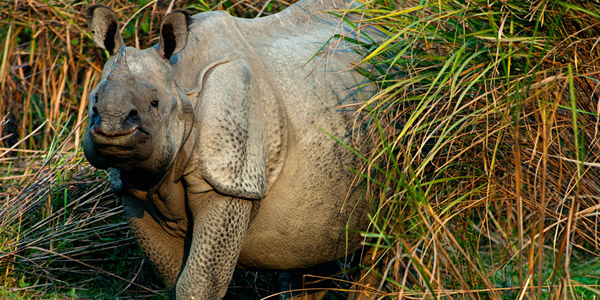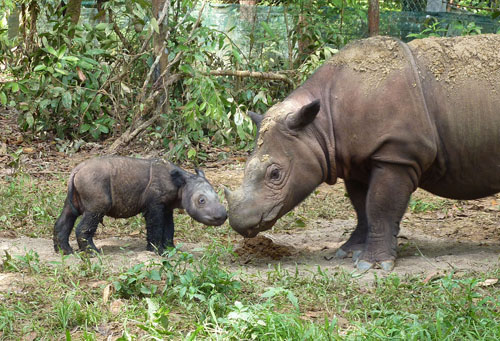25 Things You Might Not Know About Rhinos

- The word rhinoceros is a combination of two Greek words – rhino (nose) and ceros (horn).
There are five living species of rhinoceros – white, black, greater one-horned, Javan and Sumatran. In addition, a number of other animals have rhinoceros as part of their names, including the rhinoceros auklet, rhinoceros beetle, rhinoceros chameleon, rhinoceros cockroach, rhinoceros fish, rhinoceros hornbill, rhinoceros iguana, rhinoceros rat snake, rhino shrimp, and rhinoceros viper. All of them have horn-like appendages on their noses. - Rhinos have also been referred to as pachyderms.
The name pachyderm also comes from two Greek words – pachys (thick) and derma (skin). Many years ago, zoologists grouped a number of thick-skinned species together as pachyderms, including rhinos, tapirs, horses, elephants, hippos, pigs, peccaries, and hyraxes. This classification is no longer considered useful, but the name is still used every now and then. - Rhino is sometimes used as a nickname.
A number of people have been given the nickname Rhino. They include American professional wrestler and actor Terry Gerin (Rhyno), Mark Smith from the British show Gladiators, guitarist Larry Reinhardt (El Rhino) from the band Iron Butterfly, and David Unsworth, a former British soccer star. The national rugby teams of South Africa and Indonesia are also known as the Rhinos. - Rhino horns are not made of bone, but of keratin, the same material found in your hair and fingernails.
A rhino’s horn is not attached to its skull. It is actually a compacted mass of hairs that continues to grow throughout the animal’s lifetime, just like our own hair and nails. The longest horn on record belonged to a white rhino and measured just under 60 inches (five feet). By comparison, a woman from Las Vegas, Nevada is believed to have the world’s longest fingernails – about 10 feet worth on each hand – while a woman from China apparently holds the record for the world’s longest hair – over 18 feet in length! Regrettably, neither human hair nor fingernails are believed to possess the healing properties that some people believe are found in rhino horn. If people believed they did, they could chew their own nails and cut their own hair in order to feel well, and halt the needless slaughter of rhinos. - A fossil skull first thought to be that of a dragon, turned out to be from an extinct woolly rhinoceros.
In the city of Klagenfurt, located in southern Austria, stands the statue of a legendary dragon or Lindwurm, sporting a crocodile-like body and bat-like wings. The statue was erected around the year 1500, about thirty years after a large skull had been unearthed somewhere nearby. Sculptures used the skull as a model for the dragon’s head, but it was only centuries later that scientists identified it as belonging to the extinct woolly rhinoceros of the last Ice Age. - The closest living rhino relatives are tapirs, horses and zebras.

Grevy’s zebra These animals are known as perissodactyls or odd-toed ungulates. Even toed-ungulates are called artiodactyls and include cattle, deer, antelopes, goats, sheep, pigs, camels and llamas. Rhinos have three toes on each foot so, in a way, their tracks resemble the Ace of Clubs.
- A group of rhinos is called a crash.
A group of deer is called a herd, a group of fish a school, a group of bats a colony, a group of turkeys a flock, a group of bees a swarm, a group of alligators a congregation, a group of clams a bed, a group of frogs an army, a group of penguins a rookery, a group of hyenas a clan, a group of lions a pride, a group of wolves a pack, a group of coyotes a band, and a group of crows a murder. Who thinks of these names? - Some rhinos use their teeth – not their horns – for defense.
When an Indian rhino defends itself against a predator or another rhino, it doesn’t use its horn to gore its opponent. Instead, it slashes and gouges viciously with the long, sharp incisors and canine teeth on its lower jaw. Neither the black nor the white rhino has incisors. Only the Indian and Sumatran rhinos have canines, but all five species have three premolars and three molars on each side of their upper and lower jaws. Commit this to memory … there will be a quiz tomorrow! - An adult white rhino can produce as much as 50 pounds of dung per day!
That’s a lotta poo! And it’s the result of rhinos having to consume large amounts of plant material to obtain proper nutrition. Nuances in the smell of dung can tell a rhino a lot about others in the area. Each rhino’s smell is unique and identifies its owner. The dung of a young rhino smells different than that of an adult. A male’s dung smells different than a female’s, and the dung of a female in estrus gives off a different odor than that of a non-reproductive female. Multiple or communal deposits of dung are known as middens, essentially serving as local “websites” or ”Facebook pages”, allowing rhinos to keep up with their neighbors. - White rhinos aren’t white and black rhinos aren’t black.
The white rhino’s name is taken from the Afrikaans word “wyd,” which means “wide” and describes its mouth. Early English settlers in South Africa misinterpreted the “wyd” for “white”. Black rhinos probably got their name from the dark wet mud in their wallows that made them appear black in color. Both species are essentially gray in color. By comparison, the famous Blue Rhino, corporate logo for the well-known propane tank company, is entirely a figment of its founder’s imagination. - Rhino pregnancies last 15 – 16 months!
The only animals with longer gestation periods are elephants, which carry a fetus for close to 2 years! Camels and giraffes have pregnancies lasting 13 to 14 months, while female horses, sea lions and dolphins can require up to a year to give birth. A bear’s gestation period is about seven or eight months, a lion’s less than four, and domestic dogs and cats about two. The record for the shortest mammalian pregnancy is 12 to 13 days, held jointly by the Virginia opossum, the water opossum or yapok of Central and South America, and the native cat of Australia. - Rhinos and elephants are not mortal enemies.
 The myth of hatred between these two species dates back to ancient times. In fact, in 1515, King Manuel I of Portugal decided to see if it were true. He had been given a female Indian rhino by the name of Ganda, who was given a home in his royal menagerie, away from the elephants. One day, however, the King arranged for a battle between the beasts, held in a courtyard and attended by the royal family and their guests. The youngest elephant in the King’s menagerie was led into the arena from its stable. The tapestries hiding the rhinoceros were drawn open. An official observer wrote that the rhinoceros appeared furious and immediately charged her foe, so violently that the young elephant broke free of her chain, uttered a tremendous cry and bolted to safety through a thick set of iron bars. This incident most certainly helped sustain the myth.
The myth of hatred between these two species dates back to ancient times. In fact, in 1515, King Manuel I of Portugal decided to see if it were true. He had been given a female Indian rhino by the name of Ganda, who was given a home in his royal menagerie, away from the elephants. One day, however, the King arranged for a battle between the beasts, held in a courtyard and attended by the royal family and their guests. The youngest elephant in the King’s menagerie was led into the arena from its stable. The tapestries hiding the rhinoceros were drawn open. An official observer wrote that the rhinoceros appeared furious and immediately charged her foe, so violently that the young elephant broke free of her chain, uttered a tremendous cry and bolted to safety through a thick set of iron bars. This incident most certainly helped sustain the myth. - The white rhino is the largest rhino species and the largest land mammal after the elephant.
White rhinos can grow to weigh more than 5,000 pounds, which is almost as much as a Land Rover rolling along on the Serengeti. Next in size is the Indian or greater one-horned rhino, which may actually stand taller than a white rhino, but is just a bit less massive. Then come the Javan rhino and the black rhino. The Sumatran rhino is the smallest of its kind, with the largest individuals barely reaching a ton in weight. A large male hippopotamus can actually exceed the largest rhino in size – perhaps by as much as half a ton – but because it spends most of its time in rivers and lakes, biologists consider it an aquatic, not a land mammal. - Perhaps the most famous rhino in the world was one named Clara.
Clara was a female Indian rhinoceros who toured Europe for 17 years during the 1700s. Clara’s mother was killed by hunters in Assam, India in 1738, after which she was adopted by Jay Albert Sichterman and became a household pet. Clara was then sold to a Dutch sea captain, Douwemunt Van der Meer, who somehow got her safely to Rotterdam, rubbing down her skin with fish oil and providing dietary supplements of beer and tobacco. Clara’s European travels are documented in a book called Clara’s Grand Tour by Glynis Ridley, and included stops in The Netherlands, Germany, Austria, Switzerland, Poland, France, Italy, Denmark, and England. - African rhinos have a symbiotic relationship with oxpeckers, also called “tick birds”.
In Swahili, the oxpecker is called askari wa kifaru, which means “the rhino’s guard”. The oxpecker eats ticks and other insects that it finds on the rhino, and creates a commotion when it senses danger. This helps alert the rhino. Indian or greater one-horned rhinos have similar symbiotic relationships with other bird species, including the well-known myna. - Throughout their history, rhinos have been a very diverse group.
Paleontologists believe that at least 30 genera and 60 different species of rhino ancestors once inhabited North America, Europe, Asia and Africa. The extinct species Paraceratherium, commonly referred to as the “giraffe-rhinoceros”, was the largest land mammal that ever lived. Its head reached a height of nearly 28 feet – as tall as a three-story building – and paleontologists estimate that it may have weighed as much as 20 tons! The smallest rhino ancestors were the Hyracodontidae, which were only the size of dogs. There was also a group of aquatic, hippopotamus-like rhinos, the Amynodontidae, that lived in North America and Asia. - Humans are the major threat to rhinos, but several other species are also rhino predators.
The two species most often reported to prey upon rhinos – usually young ones – are lions in Africa and tigers in Asia. However, leopards, hyenas, wild dogs and Nile crocodiles are also known to kill African rhino calves on occasion. By far, though, people are rhinos’ #1 enemy. - Most wild rhino calves never meet their fathers.
After mating, adult male and female rhinos typically go their separate ways. After the calf is born, it will probably spend a couple of years or more in the company of its mother, and perhaps associate with other females and their calves, but the father rhino is not part of the standard social group. - Three of the five surviving rhino species – the black, Javan and Sumatran – are Critically Endangered.
This means there is at least a 50% chance that these species could become extinct sometime this century. Between 5,000 – 5,400 black rhinos now survive in nine African countries, essentially double the number that existed only 20 years ago, so that species is actually increasing slowly. Sumatran rhinos used to be found from the foothills of the Himalayas to the island of Sumatra. Today, however, not more than 80-100 individuals are believed to survive as scattered populations in Indonesia. The historic range of the Javan rhino was similar to that of the Sumatran, but the species currently numbers no more than 67 individuals, all restricted to Ujung Kulon National Park on the western tip of Java. - The black rhino has a prehensile upper lip that allows it to feed on trees and shrubs.
The black rhino also has no front incisor teeth, so it relies heavily on its lips to bring food to its mouth. By contrast, the white rhino, the other African species, has a long, flat upper lip that is designed more for grazing on grasses. The black rhino can be compared to a tree pruner and the white rhino to a lawn mower. The upper lips of the three Asian rhino species are also prehensile to some degree, and other mammals with prehensile lips include bears, giraffes, horses, llamas, moose and manatees. - Black, white and Sumatran rhinos have two horns; Javan and greater one-horned rhinos have one horn.
The Sumatran rhino, although it has two horns, is not at all closely related to Africa’s black or white rhinos. It is the oldest of the living rhinos, having appeared nearly 15 million years ago, and its closest relative is actually the extinct woolly rhinoceros. Black and white rhinos appear to have evolved from a common 6 million-year-old ancestor and remain very closely related. The evolutionary paths of the greater one-horned rhino and the Javan rhino separated a bit more recently, their common ancestor dating back perhaps two to four million years. Curiously enough, most female Javan rhinos don’t appear to have any horn at all! Is a hornless rhino an oxymoron? - Rhino horn has been used for centuries in traditional Asian medicine, but has not been proven to cure any illness.
Powdered rhino horn has been prescribed by Asian doctors for centuries as a cure for a wide range of diseases or conditions including aging, arthritis, asthma, black magic, boils and carbuncles, chest cold, chicken pox, convulsions, coughs, demonic possession, diphtheria, dog bites, dysentery, epilepsy, fainting, fever, fits, food poisoning, hallucinations, headache, hemorrhoids, impotence, insanity, laryngitis, lumbago, malaria, measles, melancholy, memory loss, myopia, night blindness, nightmares, nose bleed, plague, polio, prescription overdoses, rectal bleeding, scorpion stings, smallpox, snake bite, toothache, typhoid, vomiting and worms. There is no evidence from western scientific studies that it has any curative powers but at least one Chinese study disputes those data. And, of course, its use is illegal. - Andatu was the first rhino ever born in captivity in Indonesia.
 On June 23, 2012, the female Sumatran rhino known as Ratu gave birth to a 60-pound male at the Sumatran Rhino Sanctuary, located in Indonesia’s Way Kambas National Park. Approximately 16 months earlier, Ratu had mated with the male rhino, Andalas, who was born at the Cincinnati Zoo in 2001 – the first Sumatan rhino born in captivity in over a century. Andalas’ and Ratu’s baby was named Andatu, a combination of his parents’ names, but also an expression that means “A Gift from God”, in the Indonesian language.
On June 23, 2012, the female Sumatran rhino known as Ratu gave birth to a 60-pound male at the Sumatran Rhino Sanctuary, located in Indonesia’s Way Kambas National Park. Approximately 16 months earlier, Ratu had mated with the male rhino, Andalas, who was born at the Cincinnati Zoo in 2001 – the first Sumatan rhino born in captivity in over a century. Andalas’ and Ratu’s baby was named Andatu, a combination of his parents’ names, but also an expression that means “A Gift from God”, in the Indonesian language. - The most famous piece of rhino artwork is Albrecht Durer’s woodcut, The Rhinoceros, printed in 1515.
The fact that Durer’s rhinoceros is not entirely accurate is not surprising. Durer never laid eyes on a living rhino, but made his famous drawing based on the sketch of an unknown artist who had. The animal was originally sent as a gift from Sultan Muzafar II of India to Alfonso d’Albuquerque, the governor of Portuguese India at the time, who subsequently “re-gifted” it to Dom Manuel I I, the King of Portugal. Dom Manuelwho then “re-gifted” it again to Pope Leo X in Rome. Unfortunately, the boat carrying the unfortunate rhino sank before it reaching its final destination, but the animal’s image has been reprinted countless times over the centuries. - World Rhino Day is celebrated on September 22
Each year in September, people who want to help save rhinos from extinction can do so by participating in World Rhino Day. To learn how you can help, just go to: http://teamrhino.org/

8 thoughts on “25 Things You Might Not Know About Rhinos”
Reblogged this on YeduLani (YOUR ZIMBABWE) magazine.
Reblogged this on Sherlockian's Blog.
Hey! I am highly curious about that chinese study cited under 22.
Where can I find this?
Thanks!
Hi Julie,
Paul Pui-Hay But, Yan-Kit Tam and Lai-Ching Lung, ‘Ethnopharmacy of rhinoceros horn. II: antipyretic effects of prescriptions containing rhinoceros horn or water buffalo horn’ (1991) 33 Journal of Ethnopharmacy 45-50.
The Decoction tested included rhino horn and eight herbs: bambusa, coptis, lonicera, ophiopogon, forsythia, rehmannia, salvia, and scrophularia.
In the early 1990s, Paul Pui-Hay But, Yan-Kit Tam and Lai-Ching Lung found buffalo horn to be a viable substitute for rhinoceros horn in replicating the antipyretic effects of a traditional Qingying Decoction (saiga antelope horn was also tested but found to not be as effective). The team’s findings were consistent with results from a 1979 study published out of the School of Pharmacy, Beijing Medical University.
The two longest Rhino horns on record where shot by Ruelyn Gordon-Cumming about 1830/35 in what is now South Africa.
They measured 62.1/4″ and 54.1/2″ long respectivley. I have seen and measured these horns in Scotland at the ancestral home of Ruelyn Gordon-Cumming. Regretfully, they were stolen and cut up some years ago. The pictures I took of these horns can be seen in the re-print of James Mellon’s book African Hunter. Published by Safari Press.
Hi I am a 9 year old girl I love rhinos can you give me any idea of any more websites about rhinoceroses please and thank you.